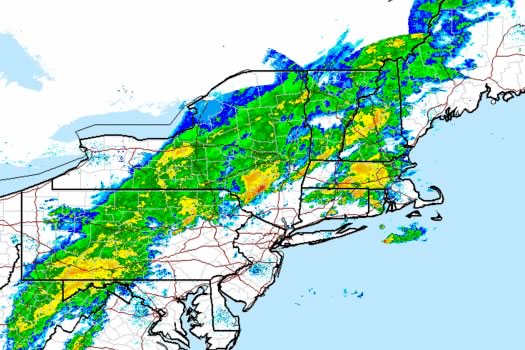

(Nat'l Weather Service Text) Color enhanced imagery is a method meteorologists use to aid them with satellite interpretation. To see the infrared imagery in motion, Animation of infrared radar satellite image Pacific Daylight Time (during the summer). Pacific Standard Time (during the winter) and 8:15 a.m. It's eight hours ahead of Pacific Standard Time (in the winter, fall back) and seven hours ahead of Pacific Daylight Time (in the summer, spring ahead). "UTC" (displayed on the image) is "Universal time" (formerly called "Greenwich Mean Time"). The National Weather Service has also produced the Doppler Radar overlaid with mountains, rivers, county lines, weather warnings, an explanatory legend and links to other NWS/NOAA related products, To access it, click here. Learn more about these reflectivity color scales. The higher the dBZ, the stronger the rainrate.

Typically, light rain is occurring when the dBZ value reaches 20. The scale of dBZ values is also related to the intensity of rainfall.

In fact, "z" can be less than 1 mm^6/m^3 and since it is logarithmic, dBz values will become negative, as often in the case when the radar is in clear air mode and indicated by earthtone colors. A small "z" means little returned energy. When the "z" is large (many drops in a cubic meter), the reflected power is large. Mathematically:ĭBz= 10 * log (z/z0) Where z = reflectivity factor and Z0 is defined to be 1 mm^6/m^3 The "z" is the ratio of the density of water drops (measured in millimeters, raised to the 6th power) in each cubic meter (mm^6/m^3). The "dB" in the dBz scale is logarithmic and has no numerical value, but is used only to express a ratio. The Doppler radar does not determine where rain is located, only areas of returned energy. As the strength of the signal returned to the radar increases the dBZ values increases. Called echoes, the reflected intensities are measured in dBZ (decibels of z). The colors are the different values of energy that are reflected back toward the radar. What do the colors mean in the reflectivity images? The Doppler Radar also lets you judge relative rainfall amounts : If both sites are unavailable, try Alternate NOAA regional radar sites. Click refresh or reload on your browser for most recent image. In-Motion Ventura County (Sulphur Mtn) in-motion Doppler Radar
#National weather service doppler radar in motion plus#
NOAA/Nat'l Weather Service Monitor at LGBįorecasts (highs/lows may differ considerably depending on distance from shore.):ĭoppler radar/satellite images from the National Weather Service (NWS) plus explanatory details and further weather links below.


 0 kommentar(er)
0 kommentar(er)
